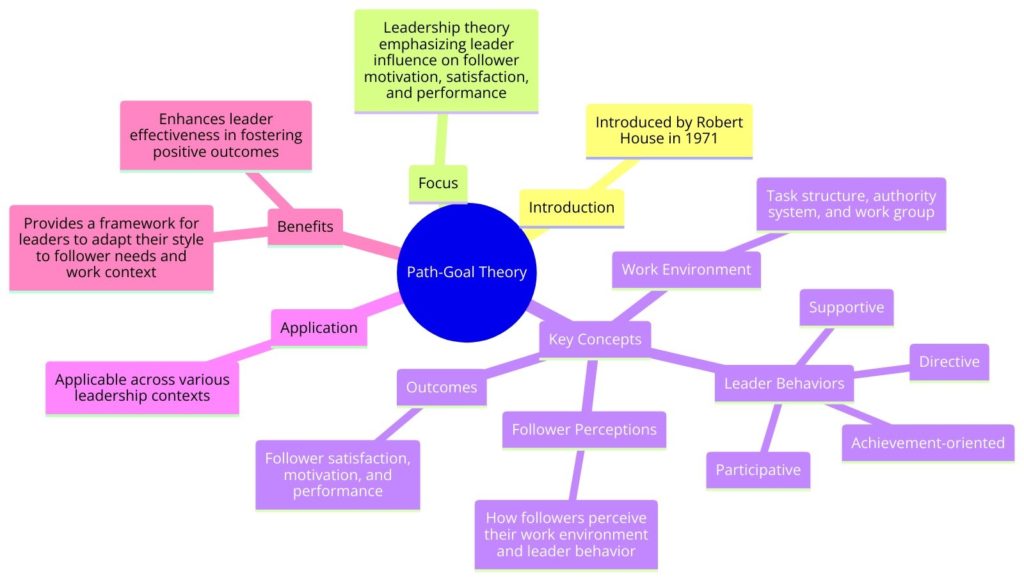Path-Goal Theory
Robert House’s Path-Goal Theory, introduced in 1971, is a leadership theory that emphasizes how leaders can influence the motivation, satisfaction, and performance of their followers. This theory integrates the motivational principles of expectancy theory, suggesting that a leader’s behavior is contingent upon the satisfaction, motivation, and performance of their subordinates. House later refined the theory in 1996, along with Terence R. Mitchell, to address some of its initial criticisms and to incorporate the concept of situational leadership more thoroughly.
What is Robert House’s Path-Goal Theory?
The essence of the Path-Goal Theory is that it’s the leader’s responsibility to clarify the path to the workers’ goals, to help them overcome any obstacles or barriers to achieving those goals, and to increase the rewards along the path. The theory proposes that leaders adopt a style that complements the situation and the characteristics of the followers, effectively enhancing follower motivation and contributing to their goal achievement.
The Path-Goal Theory identifies four leadership behaviors:
- Directive Leadership: Providing specific directions and clarifying expectations, similar to task-oriented leadership. It is most effective in ambiguous situations or when tasks are complex.
- Supportive Leadership: Showing concern for the followers’ well-being and creating a friendly working environment. It’s particularly effective in stressful situations or when tasks are physically or psychologically demanding.
- Participative Leadership: Involving followers in decision-making is ideal when followers are experienced, and their input is valuable for task completion.
- Achievement-Oriented Leadership: Setting challenging goals, expecting followers to perform at their highest level, and showing confidence in their abilities. This style is most effective when tasks require a high level of performance.
Why It Is Valuable
The Path-Goal Theory is valuable for several reasons:
- Enhances Motivation and Satisfaction: By aligning leadership styles with follower needs and task demands, leaders can effectively motivate their team, leading to higher job satisfaction and performance.
- Promotes Flexibility: The theory encourages leaders to adapt their style based on the situation, promoting a more dynamic and responsive leadership approach.
- Clarifies Goals: It emphasizes the importance of making the path to goal achievement clear for followers, thereby reducing ambiguity and increasing efficiency.
- Addresses Follower Needs: By considering the needs of followers, including their desire for autonomy, affiliation, and achievement, leaders can better support and engage their teams.
When and How to Use It
Leaders can apply Path-Goal Theory in a variety of contexts, including project management, team leadership, and organizational change initiatives. To effectively use this theory, leaders should:
- Assess the characteristics of the followers, including their experience, skills, and motivation levels.
- Analyze the task and the working environment to identify potential obstacles to goal achievement.
- Select and implement the leadership style that best addresses the needs of the followers and the demands of the situation.
- Continuously monitor progress and adjust their leadership approach as needed to ensure followers are supported in achieving their goals.
Shortcomings/Criticisms
Despite its contributions to leadership theory, Path-Goal Theory has faced criticisms:
- Complexity in Application: The theory’s reliance on accurately assessing numerous situational variables can make it difficult to apply in practice.
- Limited Empirical Support: Some research has found mixed results regarding the effectiveness of the different leadership styles proposed by the theory.
- Overemphasis on Leader Behavior: Critics argue that the theory may overemphasize the role of leader behavior in influencing follower outcomes, underestimating the impact of external factors and follower characteristics.
Robert House’s Path-Goal Theory offers a comprehensive framework for understanding how leaders can effectively influence follower motivation and satisfaction through adaptive leadership styles. While it presents leaders with a valuable tool for enhancing team performance, it also requires careful consideration of situational variables and the dynamic nature of leadership.


